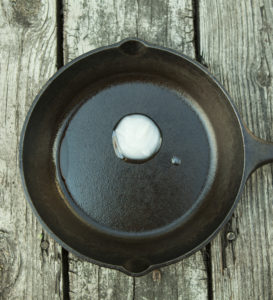 Knowing the best cooking fats is an important tool in the prevention of oxidative stress.
Knowing the best cooking fats is an important tool in the prevention of oxidative stress.
Fats: A Small Change with a Big Impact
A recent article in Food and Nutrition Research looked at the prevalence of cardiovascular disease in 42 different European countries. The objective was to identify the dietary practices that were most strongly associated with CVD. You know what WASN’T associated with CVD? Fat and cholesterol. You know what WAS? Carbs and alcohol. For decades we’ve been told that fats, especially saturated fats, are the culprit despite mounds of evidence stating otherwise.
“The major correlate of high CVD risk was the proportion of energy from carbohydrates and alcohol, or from potato and cereal carbohydrates. Similar patterns were observed between food consumption and CVD statistics from the period 1980–2000, which shows that these relationships are stable over time.” (Full text)
I know that it’s hard to rewire your brain to stop believing that fat is bad, but the science just doesn’t support a low fat diet. You also have to ignore any dietary advice produced by the U.S. government. Our USDA dietary recommendations are still reflecting ideas of the past (actually, they’re reflecting lies fed to us for capital gain, but that’s beside the point), stating that a low fat diet, especially saturated fats, is most beneficial for our health. The 2015-2000 Guidelines recommend replacing coconut oil with olive oil, canola oil and other plant-derived unsaturated fats. This statement is incredibly problematic in a number of ways, but I want to focus on the best cooking fats.
The Best Cooking Fats
Saturated fats are the best cooking fats. Fats are made of long carbon chains with attached hydrogen atoms. A saturated fat is one in which the carbons are “saturated” with hydrogens, there’s no space for additional atoms to attach. An unsaturated fat is one in which all of the bonds are not saturated, thus more atoms can potentially attach.
There are a number of ways to elicit a chemical change, but one of those ways is to add heat. If you’re cooking with saturated fats, there is no change in the fat structure (unless heated to the smoking point) because all carbon bonds are saturated… they’re fat and happy, so to speak. But heating an unsaturated fat causes those carbons to seek out other atoms. In their seeking, they can react with and oxidize whatever it is that you’re cooking. And oxidation isn’t a good thing when you’re talking about food.
You know how we’re always concerned with eating enough antioxidants? Well, these are to combat and neutralize the oxidants. I won’t go into any more detail other than to say that it doesn’t make sense to cook your vegetables in olive oil (an unsaturated fat), which oxidizes your food, and then hope to reap the antioxidant benefits from those foods. Make sense? You need to use saturated fats, which are heat-stable for cooking. Saturated fats are the best cooking fats.
Saturated Fats
Please know that I’m not saying you shouldn’t eat olive oil. I’m saying that you shouldn’t cook with it. I use olive oil to dress vegetables after they’re cooked all the time. But, I stick with the following saturated fats for cooking purposes only:
- Lard – I make my own from pig fat purchased at the Farmer’s Market, but you can find a number of great options from Thrive Market. Natural food stores are also starting to carry animal fats for cooking.
- Tallow – Tallow is the beef fat equivalent to lard. Again, make your own or check out Thrive Market or your local health food store.
- Grass Fed Butter – The nutrition profile changes based on the way in which the cow was raised, so never skimp on meat or dairy products. Grass fed is the only way to go.
- Ghee – Ghee is clarified butter. Again, grass fed is important. It’s often better tolerated than butter for those with a dairy sensitivity.
- Coconut Oil – Compared to lard and tallow, coconut oil has a lower smoke point, thus needs to be cooked at lower temperatures, but it’s fabulous. I even use it for eggs.
- Leftover Animal Fat – Any time I cook ground beef, ground pork or bacon, I save the excess fat in a small mason jar. There’s often a thick fat layer on top of some liquid. The liquid can go bad, so I do store these fats in the fridge.
Leave a Reply